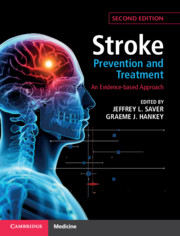Book contents
- Stroke Prevention and Treatment
- Stroke Prevention and Treatment
- Copyright page
- Dedication
- Contents
- Contributors
- Preface
- Part I Foundations
- Part II Systems of Care
- Chapter 3 Prehospital Stroke Care and Regionalized Stroke Systems
- Chapter 4 Organized Stroke Care
- Part III Acute Treatment of Ischaemic Stroke and Transient Ischaemic Attack
- Part IV Acute Treatment of Haemorrhagic Stroke
- Part V Prevention
- Part VI Stroke Rehabilitation and Recovery
- Index
- References
Chapter 3 - Prehospital Stroke Care and Regionalized Stroke Systems
from Part II - Systems of Care
Published online by Cambridge University Press: 15 December 2020
- Stroke Prevention and Treatment
- Stroke Prevention and Treatment
- Copyright page
- Dedication
- Contents
- Contributors
- Preface
- Part I Foundations
- Part II Systems of Care
- Chapter 3 Prehospital Stroke Care and Regionalized Stroke Systems
- Chapter 4 Organized Stroke Care
- Part III Acute Treatment of Ischaemic Stroke and Transient Ischaemic Attack
- Part IV Acute Treatment of Haemorrhagic Stroke
- Part V Prevention
- Part VI Stroke Rehabilitation and Recovery
- Index
- References
Summary
Prehospital stroke care is the first link in the stroke chain of survival and includes symptom recognition, engagement of the Emergency Medical Services (EMS) system, timely and effective dispatcher response, and emergency medical response. Prehospital stroke screening tools are an important component in guiding the EMS response to stroke and proper triage of patients. Additionally, there is a growing body of research focused on applications for telemedicine, mobile stroke units, and diagnostic testing in the prehospital arena. Prehospital stroke care is integral to the organization of regionalized stroke systems. Implementation of stroke systems of care can lead to improved access to specialty services and improved patient health outcomes. In addition to increasing access to acute stroke care, telestroke shows great potential for integrating stroke systems of care and facilitating interactions between centres.
Keywords
- Type
- Chapter
- Information
- Stroke Prevention and TreatmentAn Evidence-based Approach, pp. 35 - 58Publisher: Cambridge University PressPrint publication year: 2020

